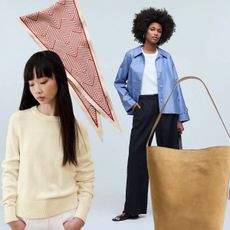The Very Best Makeup Brushes for Every Step in Your Routine

It would be hard to put on your makeup without some good makeup brushes. Sure, in some cases and for some products, you could use your fingers to dab and blend, but you're going to need a few brushes for application. Shopping for a makeup brush can be overwhelming, though. There are so many brands, options, and styles. And then there's always the question—do I really need a 20-piece set of brushes that costs hundreds of dollars? Yes, some brushes can be pricey too.
If you've ever caught yourself wondering about these things and if certain brushes are worth it, I've got you covered. I've been thinking about those things, too, and decided to go to people who probably know about every type of brush, bristle, and brand out there: makeup artists. I asked them to help break down the different types and how to shop for the perfect brush. I put it all into this guide for you below.
How to Shop for Makeup Brushes
First, let's start with shopping tips. Should you shop for them individually or buy a set? Well, it looks like a package deal is best. "If you're just starting out, look for brushes that come in a set," says makeup artist Renée Loiz. "This way, you will get more bang for your buck. Getting the basics (powder, blush, foundation, concealer, eye shadow, crease, lip) is really all you need. Top that off with a stellar brush cleanser and you're good to go!"
Makeup artist Maya René suggests opting for full-size brushes rather than travel-size ones. "Although they're cute in size and can fit in your purse, they're just not practical," she says. "I guarantee the application won't come out as flawless unless you have a teeny-tiny face. However, if you come across a brush set with the full-size brush head and just a travel-size handle, then that's worth looking into. Sephora and Morphe are great places to shop to start your collection!"

Bristles and Shapes
Bristles and brush shapes might not be the first thing you consider when shopping for a brush, but the types you choose could make or break your makeup application. It depends on what types of makeup formulas you'll use more often (liquid, powder, etc.) and what kind of look you are going for.
When it comes to bristles, there are natural, synthetic, and a blend of both. René says duo-fiber brushes (a blend of synthetic and natural hair) are great for buffing and blending in cream or liquid products and leave an airbrushed, seamless look. You can also use them for some powder products. Synthetic brushes are great for skincare application and liquid or cream foundations and concealers. Natural brushes are mainly used for loose or pressed powder products. And some brushes are dense or loose. "Short, dense brushes are great for contouring or applying full-coverage foundations to skin with texture, whereas loose, fluffy brushes are great for light applications of products," René explains.
As for shapes, René says there's no wrong way to use them, but she gave some ways she personally uses each:
Tapered: Great for blending.
Flat/Dense: Full-coverage application or creating shapes on the face (like contouring with cream products).
Fluffy/Round: Great when used for concealers, eye shadows, blushes, highlighters, and blending out harsh lines.
Fluffy Angled/Tapered: Great for bronzers, blushes, sometimes highlighters.

Types of Brushes
Of course, when you're shopping for a brush, you're mostly going to pay attention to the types of brushes out there. And there are so many. Here's a breakdown of the most common ones and their uses.
Foundation Brush
Normally, a foundation brush is flat with wide bristles and is used to apply cream and liquid foundations, Loiz says. "The brush should be flexible and move easily around your face when applying. [It] can also be used to apply cream or liquid blushes and bronzers," she adds.

Loiz's recommendation is now sold out, but here is another popular option worth checking out.
Customer review: "Love this brush! Buffs out foundation really well because the brush is a bit more dense, which creates a flawless finish. One of my favorite brushes!"
Pro: Offers an airbrushed, second-skin look.
Con: Sheds frequently after it's been washed.
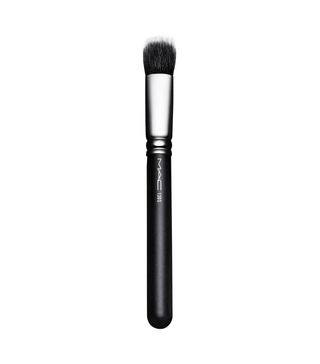
This brush can be used for foundations, creams, emulsions, and select powder products. "When I'm working, I use this brush for everything, from moisturizer application to liquid or cream foundations and even cream blushes. It really creates a beautiful finish on the skin and grabs just enough product," René says.
Customer review: "I've got lots of MAC brushes and this one is amazing and easily my favorite. It's great for priming, blending concealer and foundation, and contouring. Definitely worth the price!"
Pro: Allows for a smooth and even base.
Con: Has a tendency to shed during application.
Powder Brush
"A powder brush is used to apply any type of powder, from loose to pressed to foundation powders," Loiz says. "It's usually the larger brush out of the pack and has a wider bristle shape." Makeup artist Tobi Henney adds that it can be used to eliminate any shine on the T-zone.
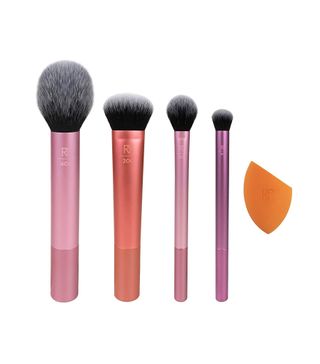
"I'm a huge fan of Real Techniques' brush sets because they're super affordable and have a variety of different sets that cater to every makeup artist's needs," Loiz says. This set includes brushes for setting powder, foundation, highlighter, eye shadow, and blush.
Customer review: "These brushes are extremely easy to use for beginners and help blend so well! The descriptions that come with each one also make it easy to understand which products to use with what. I will definitely be buying these again!"
Pro: Easy to use for beginners.
Con: Bristles are incredibly soft (not ideal for stippling).

Hourglass's powder brush is dual-ended—one side is smaller and tapered, so it's great for setting the under-eye area. The other side is larger and rounded, so it can be used for allover application.
Customer review: "I absolutely love this brush—I use one side for powder and one for blush—great for travel or everyday. It doesn't shed, is super soft with just the right amount of firmness and give for powder/blush application, and feels great in my hand. Truly the perfect brush."
Pro: Both sides of the brush come to a taper for ultra-precise product application.
Con: High price point for an individual brush.
Contour Brush
The name kind of says it all—Henney says this brush is used to add more dimension to the face.
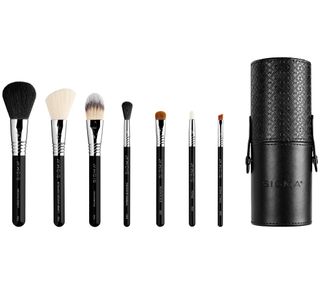
"I always point people to Sigma brushes!" René says. "They're known for having great brush sets, and online, they also provide useful tips for people looking to figure out how to use each one. It's also great because they give you a wide variety of face and eye brushes to work with for an affordable price." This particular set features everything you need for a travel-friendly look.
Customer review: "These brushes are so buttery soft even after washing. They apply and blend eyeshadow and powder like a dream. I'm highly impressed with how easy and seamlessly they work to blend. A great set with everyday brushes."
Pro: All brushes can be used with cream or powder products.
Con: Brushes are quite large and might be challenging for some to maneuver.
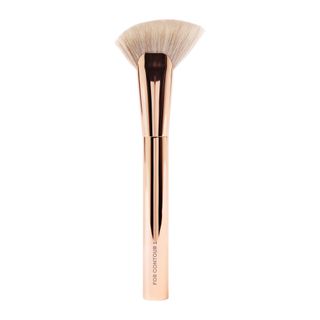
This synthetic contour brush works with both cream and powder formulas. The tapered bristles make for a soft, diffused look.
Customer review: "I love using the contour brush to apply my cream contour! Very unique brush that melts the product into your skin. I'm new to cream contour, so having the right tools to use made it so easy and quick. Definitely recommend."
Pro: Seamlessly applies cream and powder formulas.
Con: Features semi-firm bristles that could be irritable to sensitive skin.
Blush Brush
"This brush is slightly smaller than the powder brush, and the bristle shape is complementary to your cheek shape," Loiz says. "The blush brush should fit perfectly on the apples of your cheeks—where you would naturally place blush. You can also use this brush for bronzing, highlighting, or contouring."
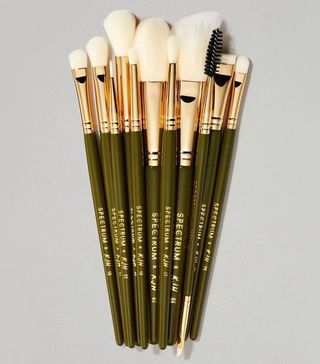
"Katie Jane Hughes's brush set from Spectrum is top-notch!" Loiz says. "They're high-quality brushes designed by one of the most amazing makeup artists in the business. I recommend these brushes for the more experienced artist!" This 11-piece set features a blush brush that can be used on powder and cream products.
Customer review: "The best constructed, easiest to use, most natural feeling brushes. This is the perfect mix of large surface and precision tools. Absolutely recommend."
Pro: Deliver a smooth, airbrushed finish.
Con: High price point.
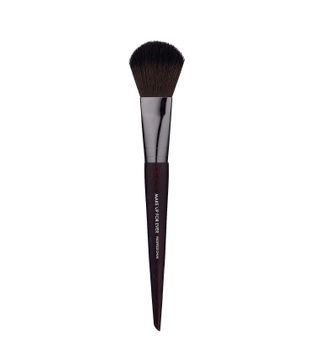
Make Up For Ever's flat, rounded brush features wavy fibers that can be used on loose and compact powders.
Customer review: "I love the size and the softness. It distributes color perfectly. You really can't go wrong with Make Up For Ever brushes. They're the best."
Pro: Brush is a versatile size and shape.
Con: Does not pick up powder blush easily.
Fan Brush
Henney says you can use a fan brush to add highlighter to the tops of the cheekbones. It can also be used to apply bronzer and setting powder.

This is a great drugstore option.
Customer review: "I use this for blush, light contour, and highlights. I don't wear a ton of makeup, so I don't exactly want to spend a ton on brushes. Happily surprised with the quality! Soft, washes well, and applies evenly. I'd prefer one a little thicker for contour but again, as I don't do that often this brush is great."
Pro: Bristles evenly distribute product.
Con: Has a tendency to shed.
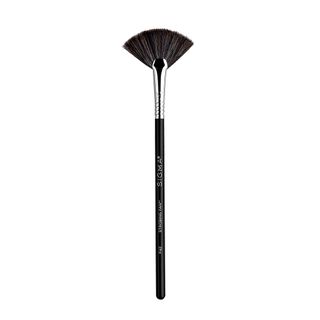
The synthetic strobing fan brush from Sigma provides medium coverage and can be used with liquid, powder, and cream products.
Customer review: "This is a great fan brush to apply highlighter to the high points of your face! You can really dust it perfectly on top of your cheekbones, and it doesn't pick up a ton of excess powder. Great brush for the price!"
Pro: Fibers are gentle and hypoallergenic.
Con: Small brush size does not cover much area.
Concealer Brush
This doesn't really need an explainer because it's another brush whose name is self-explanatory. Loiz calls it "the little sister to the foundation brush." She says it has a similar shape and bristle flexibility but is smaller—all of which make it easy to apply the product under the eyes and onto blemishes.
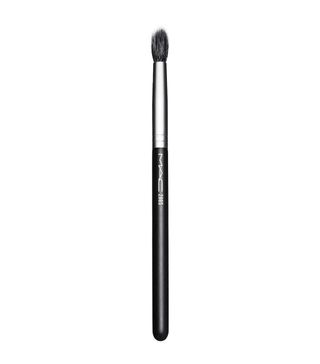
"Whenever I get a little too heavy-handed with concealer, I always reach for this brush to buff out any mistakes. It's great for blending eye shadow as well," René says.
Customer review: "The MAC angled brush is my favorite brush, and this one is my second favorite brush. It is perfect for blending shadows, and I haven't had any problem with bristles falling out. For me, it's a must-have brush. I bought one for my daughter and she loves it too!"
Pro: Duo feature makes blending easy.
Con: Absorbs product during application.
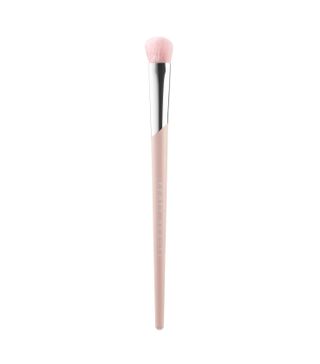
Fenty Beauty's concealer brush is slightly angled so you can precisely apply your concealer. It can be used with liquid, cream, and powder formulas.
Customer review: "This is one of my favorite brushes. I have so many brushes and tried multi of them (including beauty blender) for my under-eye area, but nothing worked as well as this brush did. I only use it with my under-eye concealer, and I 100% recommend it."
Pro: Uses super-soft synthetic bristles at an angle.
Con: Bristles separate easily with heavy use.
Pencil Brush
Henney explains that a pencil brush can be used to add highlighter to the inner eye or the brow. It also comes in handy for smudging eyeliner and eye shadow.
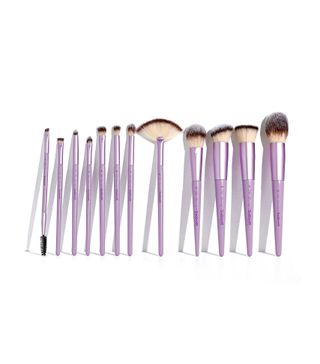
Henney's own brush collection is a 12-piece set that features a pencil brush and pretty much every other brush you'll need. "I created my Trademark Beauty The Essential Makeup Brush Collection with 12 brushes so you can complete a whole face of makeup with the set," she says. "It is enough brushes to not have to double-dip in products but also not too many brushes that it becomes overwhelming."
Customer review: "Every brush you'll ever need, including fan brush & eyebrow spoolie, which my previous sets didn't have. They're soft and velvety. The stippling brush is the perfect size and density. I like the white tips (vs. tan/brown) so I can tell when the brushes are dirty. It all fits neatly into the travel bag."
Pro: Bristles are soft and durable.
Con: None.

This pencil brush has natural bristles and a short, pointed brush head.
Customer review: "Love how this applies. I use this to apply my darker colors in the crease, and it's so small and compact that it applies loads of color right where I want it vs all over my lid."
Pro: Perfect for crease work with a short, pointed brush head.
Con: Natural bristles may irritate sensitive skin.
Crease Brush
"The name says it all. Use this slender tapered bristle brush to get eye shadow right into your crease," Loiz says. "When applying, start by placing the brush on the outer corner of your crease and gently blend inwards. Where you place the brush first is where the most color will be deposited."

This brush is sheared and tapered so you can target the application just right.
Customer review: "Amazing brush! Love it for packing more pigment while also blending beautifully. I love that it's pointed as well, especially for application on the bottom lash line."
Pro: Does not shed bristles after being cleaned.
Con: Firm bristles make diffusing vibrant pigments challenging.
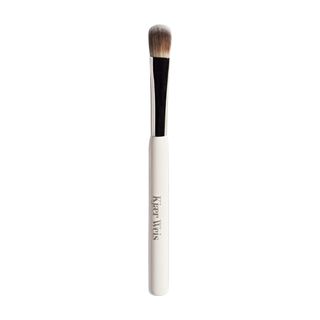
Made with synthetic bristles, this brush has a long and slim shape for contouring and adding dimension to the eyes.
Customer review: "A beautiful and high-quality brush. I use this for cream eyeshadow and as a crease brush for powder eyeshadow. The best brushes I've ever had. So nice in the hand. Good control."
Pro: Deposits the right amount of color every time.
Con: None.
Eye Shadow Brush
"This is the main brush you'll need for eye shadow," Loiz says. "It's flat and a little sturdier than the crease brush because you're tapping the color onto the eyelids instead blending and swashing the color on. Tapping with a more sturdy brush will deposit the color more evenly and show off the intensity of the color as well."

"Personally speaking, I love a lived-in eyeliner look," René says. "I think it creates a more natural and effortless look. So having this smudging brush in my kit is a must. I use it mainly to stretch out eyeliners or smudge in eye shadows along the waterline or lash line."
Customer review: "I like this Smudge Brush. It helps me to apply my eyeshadows smoothly. I use it to apply eyeshadows on my eyelids and my eyebrows and it works for both. I've been using it for a while, and I have to say that it has not changed the shape or color. Good quality!"
Pro: Provides a sheer and even application.
Con: Features dense, tough bristles that might be hard on the skin.
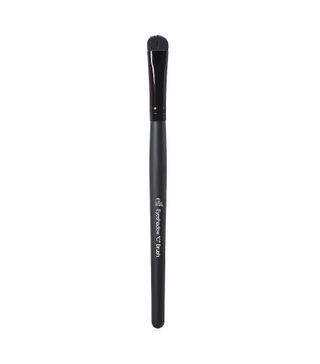
This medium-size eye shadow brush is made of synthetic bristles and can be used on wet or dry products.
Customer review: "I adore this brush. I've had it for a few years now. I like the density of the bristles and the length and the longevity of the brush."
Pro: Can be used with wet or dry products.
Con: None.
Shader Brush
"This can be used to smudge eyeliner or apply eye shadow to the top and lower lash line," Henney says.
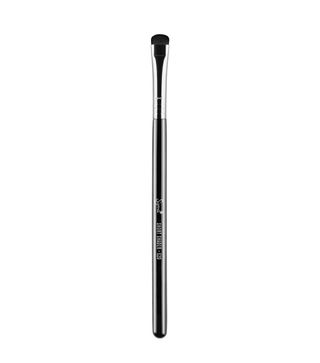
Sigma's synthetic-bristle brush has a soft, precise, flat head and provides medium to full coverage.
Customer review: "This is one of my very favorite makeup brushes. I use it to apply my eye shadow onto my very deep-set eyes. It works beautifully. I then use a bit of a larger brush to blend. Sigma brushes are by far the best I've ever used. Love this brush!"
Pro: Can be used with cream and powder products.
Con: Bristles are somewhat stiff.

The short and flat design on this brush gives you more control for precise application.
Customer review: "Not too stiff, not too flexible, and just right for apply shadows. It is soft on the eyelid and allows for good coverage while being just stiff enough to keep control of the application area."
Pro: Short, flat design provides ease of control.
Con: The bristles on the brush are quite small.
Lip Brush
Loiz says these brushes are most likely synthetic, which makes them easier to clean when using creamy lip products. "This brush is smaller in size, and the bristle shape is flat and designed to move with flexibility around the lips," she explains.
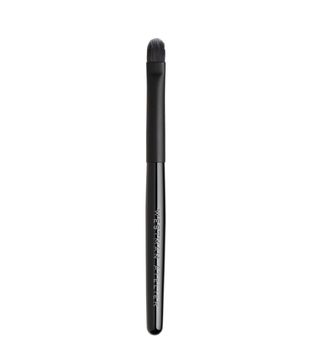
Westman Atelier's lip brush has a wider head, which enables it to pick up the right amount of pigment.
Customer review: "I really like this brush due to its heft and feel. Plus, it makes it easy to blend and build your lip shade. The small size is perfect for day-to-day as well as travel. I highly recommend."
Pro: Bristles are very gentle on the lips.
Con: Does not come with a protective cap.
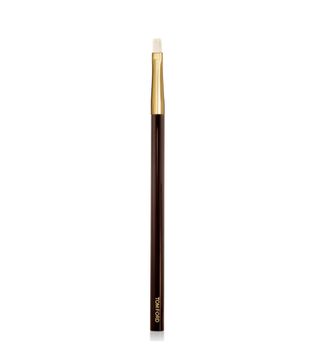
The contoured head on this brush makes it easy to enhance or modify the shape of your mouth. You could build to create sheer to full coverage.
Customer review: "I love this lip brush. It is one of the best ones that I own. The shape is a little unusual for a lip brush, but it actually works great! I am very pleased with the application of product with it."
Pro: Ideal for precise lining.
Con: Luxury price point.
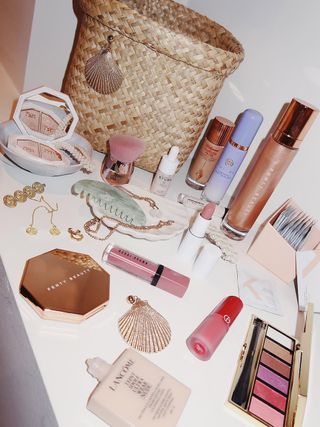
How to Care for Your Brushes
If you're able to care for brushes, they should last you a long time. "Cleaning your makeup brushes gets rid of product buildup, germs, and bacteria that has collected in them," Loiz says. "It also helps preserve the 'life' of your brushes. If you don't clean them regularly, the bristles will fray and start to break off. The brushes also will start to accumulate bacteria, which can lead to skin irritations, acne, and infections."
Henney recommends using the Beautyblender Blendercleanser Solid Pro on your brushes. "I start by running each brush from my set under some running water. Next, I lightly swipe the brush across the Blendercleanser," she says. "The next step is to run the brush over the silicone brush cleanser tool to help remove the makeup buildup from the brush. This step is best done under running water. Continue this step until the brush is completely free of makeup product. Next, it's best to squeeze all of the water from the brush, and lastly, lay the brush to dry on a countertop with the brush hair off the edge to help get as much air to all sides for a fast drying process."
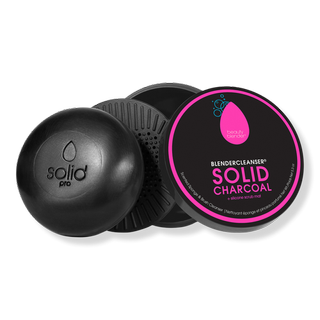
Customer review: "This product is a must-have. It literally restores my blenders and brushes to Look like new. I splurged and got the larger size, and it's so worth it. It lasts a long time and keeps my stuff super clean. If I can give 10 stars, I would."
Pro: Conditions your tools with palm oil, aloe, and coconut oil.
Con: None.
As for handling the brushes, René recommends placing your brushes in a separate bag or container to allow the brushes to maintain their original shape and reduce shedding. If you notice the hair is falling out of your brushes or the product is not coming out, then it might be time to get new ones, Loiz adds.
This post was published at an earlier date and has since been updated.
Sarah is lifestyle writer and editor with over 10 years of experience covering health and wellness, interior design, food, beauty, and tech. Born and raised in Los Angeles, she attended New York University and lived in New York for 12 years before returning to L.A. in 2019. In addition to her work on THE/THIRTY and Who What Wear, she held editor roles at Apartment Therapy, Real Simple, House Beautiful, Elle Decor, and The Bump (sister site of The Knot). She has a passion for health and wellness, but she especially loves writing about mental health. Her self-care routine consists of five things: a good workout, “me” time on the regular, an intriguing book/podcast/playlist to unwind after a long day, naps, and decorating her home.

